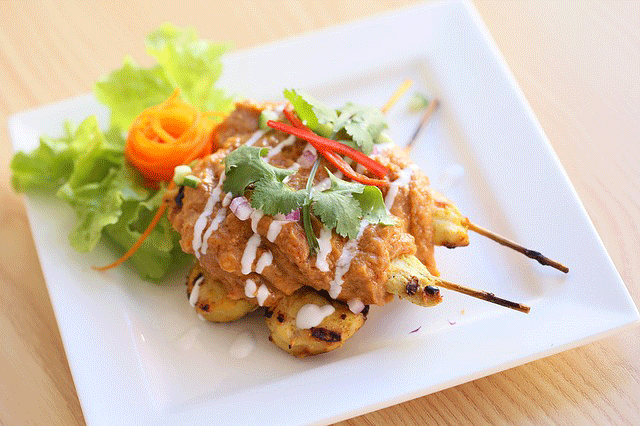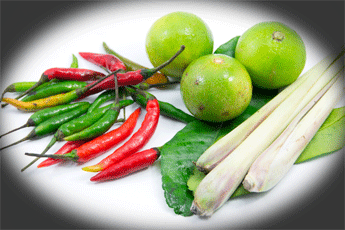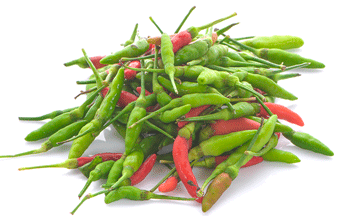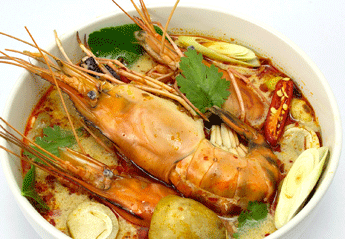
Whilst it is not entirely clear how the Chilli arrived in Thailand, it is speculated that it arrived there via the Portuguese. Ceylon (modern-day Sri Lanka), which is relatively close to Thailand, was occupied by the Portuguese from 1505 to 1658. When considering that wherever the Portuguese went, their Chillies went with them. As Sri Lanka likes extremely pungent foods, it is not unlikely that the Chilli was introduced to the island during this time. In turn, they would have found their way via trade or the flight of birds (who absolutely love Chillies) carrying seed to Thailand.

Another route that the Portuguese might have used may have been via Malacca, which they used as a base from 1511 for trading and missionary expeditions into China, Japan, and Thailand. The Portuguese missionaries would certainly have taken Chillies with them in their journeys to Thailand, as they were extremely fond of them in their cooking.
A possible link to the theory of birds carrying seeds to Thailand is that the name of a very popular Chilli in the country - the Prik kee noo - is also known as the Birds-eye pepper. This is, of course, entirely speculation, but not entirely impossible!
Whether by trade, through missionaries or birds, the Chilli arrived in Thailand. Its climate makes growing Chillies easy, so it is possible they found their way from the wild into domestication or the other way round. Whichever way, one thing is clear; the Chilli is now so entrenched in Thai cuisine that it is not going away any day soon.

The essence of Thai cooking
Chillies are an integral part of Thai cooking. The aim of Thai cooking is to achieve a balance between five different tastes – sweet, sour, spicy, bitter and salty. Various ingredients are used in Thai cuisine to accomplish this. These ingredients include ( among many others) palm and (sourness), fish sauce, soy sauce and salt ( saltiness), Birds- eye and other Chillies, galangal, black pepper and garlic (spiciness ), tamarind, lemongrass and limes (sourness) and bitter gourd for bitterness.
soy sauce and salt ( saltiness), Birds- eye and other Chillies, galangal, black pepper and garlic (spiciness ), tamarind, lemongrass and limes (sourness) and bitter gourd for bitterness.
For Thai cooking to achieve the depth of flavour that it does, these tastes all need to be in perfect harmony. Just a little too much of an ingredient can ruin the balance of a dish.
Thai cooks almost instinctively know how they achieve this. After all, they get expert coaching in their home kitchens from a young age . They cook not only by instinct, but also by taste. The food is continuously tasted as it is being made. Adjustments are made when required to balance flavours. This level of precision results in the delicate dishes we have come to know in Thai cuisine.

How Chillies are used in Thai cooking.
The Thais love their food to be hot and spicy.This love of spicy foods is something they share with their neighbours. Thailand is situated next to both India and China. These countries are among the top consumers of Chillies. While both have influenced Thai cuisine but don't think that Thailand stands in the shadows . When it comes to eating Chilies, Thailand does really well. It is right up there with the best!
As a country that loves its Chillies so much , Thailand has many ways of using them, including:
Stir-fries
The making of stir-fries illustrates the influence of Chinese cuisine on Thai cooking.  Many of these stir-fries are made with Chillies, including Pad Thai ( stir-fried noodles), Pad Prik Khing ( spicy stir-fried chicken and vegetables), Gai Pad Mamuang Himaphan ( stir-fried cashew chicken ), Hoy Lai Pad Prik Pao ( stir-fried clams with Chilli paste) hoy-lai-pad-nam-prik-pao and Neua Pad Prik On ( Stir-fried beef with mixed peppers ). Another great Thai stir -fry is Thai stir-fried noodles with Sai au sausage.
Many of these stir-fries are made with Chillies, including Pad Thai ( stir-fried noodles), Pad Prik Khing ( spicy stir-fried chicken and vegetables), Gai Pad Mamuang Himaphan ( stir-fried cashew chicken ), Hoy Lai Pad Prik Pao ( stir-fried clams with Chilli paste) hoy-lai-pad-nam-prik-pao and Neua Pad Prik On ( Stir-fried beef with mixed peppers ). Another great Thai stir -fry is Thai stir-fried noodles with Sai au sausage.
Sauces and Pastes
Sauces are used in Thai cooking mainly for dipping. Recipes in this category include Thai Chicken with Satay sauce, Nam Prik Pla Tuu-Pla-Raa ( Grilled mackerel dipping sauce), Nam Jim See Keow ( spicy seafood dipping sauce ) and Nam Jim Jaew(sweet and sour sauce made with Chillies, sticky rice and other ingredients). Other uses for sauces are for throwing over noodles as in Nam Jim Suki (bean curd with Chillies and other elements) and, Thai sweet Chilli sauce as a condiment. Pastes include Nam prik poa (chilli paste), Nam Prik Goong Siap ( a spicy prawn relish) and Phat phrik khing ( a dry curry paste).
Soups
Thailand produces some excellent soups with delicate flavours. Tom Yum Goong (spicy seafood soup) in particular is a soup that is a favourite around the world. It ranks in the top fifty dishes in the world. Other spicy soups from Thailand are Tom Ka Gai ( coconut chicken soup) and Gwaytio-nuea-Nam ( spicy beef noodle soup).
Curries
Thai curries, as they are known in the West, are a result of the influence that India has had on Thai cuisine. These curies combine ingredients with typical Thai style ingredients, including lemongrass, coconut milk, galangal, garlic and Chillies. Massaman curry (spicy Thai beef or chicken curry) and Thai green curry (green chicken curry with Chillies and Thai spicing) are examples of these types of curries
Other uses include making Chilli flakes, pickles, salads and fresh for garnishing

Types of Chillies
The Thai name for Chilli is Prik. In this list of some of the chillies commonly used in Thai cooking, you will find all of the names preceded by this title.
Prik kee noo suang (Birds eye pepper) is perhaps the most used and known. It is known outside of Thailand as “Thai Chilli” and reasonably easy to buy in other parts of the world. The name Bird's Eye Chilli and that of the African Peri- Peri are used synonymously ( although the Thai birds -eye belongs to a different species) . Thus, another link is added to the Portuguese connection (The Portuguese introduced the Peri-Peri Chilli to Africa). It is also found and known as kōcci in certain parts of Sri Lanka.

Prik kee noo suang grows from to 2 and 3 cm, with a weight of 2 to 3 grams. It is green but matures to a pungent, bright red pod with a Scoville rating of 100000 to 150000 Shu in its immature state. These chillies dry very well and are then called prik kee noo Daeng haeng. They are eaten both as a green Chilli and in its mature form. It is used in recipes like Yam Ma Maung (Thai Green Mango Salad), Prik Nam Pla (Thai Chili sauce) and Tom yum Goong (Thai prawn soup with Chillies).
Prik chee fah (Literally means Chilli pointing the sky). As the name implies, these Chillies grow to point upwards. They are quite large, growing to 15 cm and milder than the Prik Kee Noo, with a higher-end Scoville rating of approximately 70000. They ripen from a dark green Chilli with a grassy pungent flavour to a bright red colour with a sweeter taste. Widely used to make dipping sauce (Nam Jim Jaew ) and in relishes (Ma hor). It is also used in stir-fries, curries ( for its flavour and red colour giving properties) and a garnish in salads or pickled.
Prik Kaleang. The Thai people are not fond of mild Chillies. This one is no exception to the rule. It is one of the hottest Chillies found in Thailand. Their colour varies from light green, through orange to red. Used in recipes like Kaeng pa (Thai jungle curry made with pork and chicken). This Chilli is not found easily outside of Thailand.
Read more : Chillies in Thai recipes



